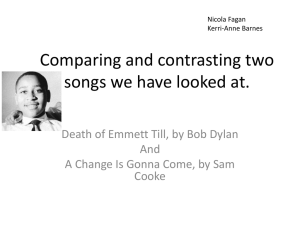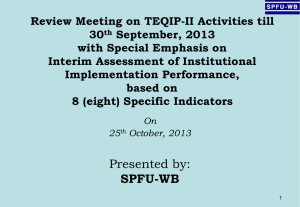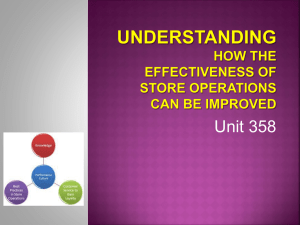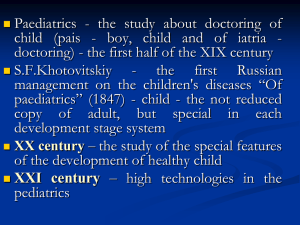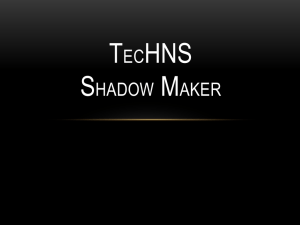354 Payment operations
advertisement
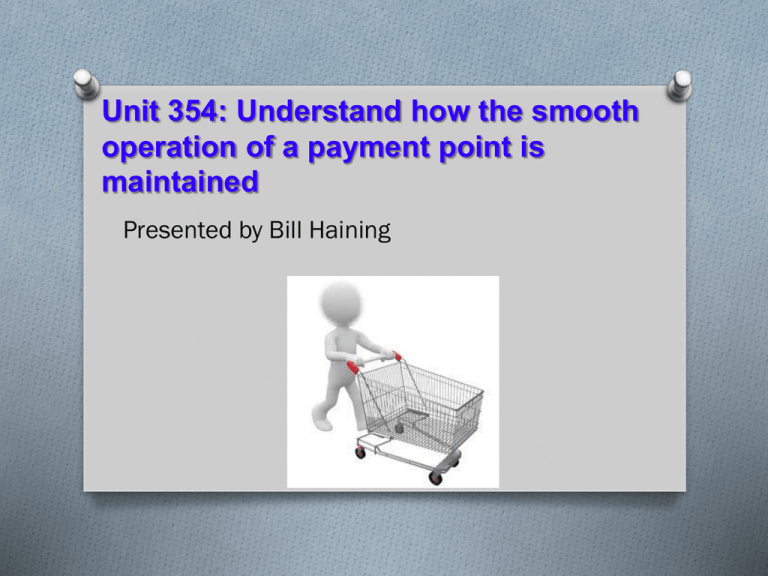
Unit 354: Understand how the smooth operation of a payment point is maintained Presented by Bill Haining how to deal Understand how the smooth operation of a payment point is maintained There are six learning outcomes to this unit. 1. Know how a payment point is made ready for trading. 2. Know how to deal with queries raised at the payment point. 3. Understand the routine monitoring of a payment point. 4. Know what actions should be taken at the payment point when abnormal operating conditions apply. 5. Understand how the accuracy of till operation is monitored. 6. Know how to implement end-of-shift procedures at a payment point. Preparing the payment point O Some payment points will need to be ready for use before the start of the day, others will be brought into use during busy periods. O To prepare the payment point for use, check that all items such as security tags, hangers, coin bags and products needing to be returned to stock have been removed from the area. O Make sure there are sufficient bags, till rolls, pens, etc. available and that the cash float is in the drawer. O Above all, make sure the payment point is tidy as this will create a favourable impression wit the customers. Preparing the payment point O Some payment points will need to be ready for use before the start of the day, others will be brought into use during busy periods. O To prepare the payment point for use, check that all items such as security tags, hangers, coin bags and products needing to be returned to stock have been removed from the area. O Make sure there are sufficient bags, till rolls, pens, etc. available and that the cash float is in the drawer. O Above all, make sure the payment point is tidy as this will create a favourable impression with the customers. Staff rotas O It is important to have enough colleagues available to operate O O O O O O payment points so that customers are served promptly and unacceptably long queues do not form. On the other hand, it is not cost effective to have colleagues on the payment point waiting for customers to appear. A rota must be drawn up which takes into account known trading patterns and trends, so that there are always enough colleagues at busy times and utilises the skills of the colleagues so those not working on the till point have been trained to do so if required. This will maximise colleagues’ availability without exceeding the colleagues’ working hours. Colleagues will have a number of contracted hours per week and exceeding these will lead to overtime payments. Exceeding the Working Time Directive will contravene employment regulations. You will also need to take into consideration holidays, sickness and whether any age-restrictions apply to the products sold, as these will all affect the number of colleagues required. Resolving queries O Colleagues operating the payment point will raise queries O O O O O O about the availability of items such as bags, till rolls, wrapping paper, sticky tape or pens. They will also need a supply of change and may look for help in answering customers’ enquiries about the availability of products and services or prices. As they will not be able to leave the payment point, you may have to help the customer by taking them to the correct area. Colleagues may also query the availability of relief for breaks. Customers will raise a variety of queries. These may be about the availability of products and services or about prices, either asking for a price or claiming that the price charged is different from the price on the ticket. They will also be looking for further assistance on the suitability of products, extended warranties, store cards, etc. Resolving queries O Possibly the most difficult query to deal with is the claim by the O O O O O customer that they have been given incorrect change. If both the customer and the colleague are adamant that they are correct, there is only one way to settle the issue and that is to reconcile the contents of the till drawer with the sales that have gone through the till. If it is a quiet trading period and it is not a security risk to do so, this may be done there and then and resolve the issue. If you have a system where there is a spare till that can be opened while the till under query is checked, or a spare float which can be put into the till while the drawer is taken away and checked, tell the customer what you plan to do and how long this action is likely to take. Agree with the customer whether they want to wait for the result or give their name, address and telephone number and be contacted when the check is complete. Whatever the result of the reconciliation, tell both the customer and the colleague. Routine monitoring O Payment points are monitored on an on-going basis through: O O O O O Observation, keeping an eye on what is happening in terms of the level of customer service being offered, whether colleagues make good use of their time when there are no customers. Also whether the till drawer is always closed immediately after use and whether the payment point is being kept clean and tidy. As well as observing this in the course of your other duties, many retailers will use mystery shoppers to report on payment point activity, as the colleagues will not be aware that they are being monitored. Spot checks on payment point housekeeping may uncover problems which can be resolved by implementing further colleague training or, if necessary, improving the existing payment point procedures. Security problems need to be addressed urgently and may involve further colleague training or, if repeated, disciplinary action. Routine monitoring may also uncover payment discrepancies which may require increased payment point checks. Abnormal operating conditions O There will be times when the operation of the payment point will be affected by abnormal operating conditions. O A contingency plan should be in place to deal with these before they happen. O Abnormal condition Action to be taken O Colleague shortages All trained colleagues to operate O O O O O payment points System breakdown Use manual backup systems Power failure If no alternative power supply available, consider temporary closure Security threats Activate store security procedures Store evacuation Lock all tills and activate store security procedures Severe weather Protect equipment and vulnerable products Reconciling the payment point O Every till needs to be reconciled at least every day and, O O O O O where a number of operators use the till in a day, more often. Till discrepancies occur because cash is incorrectly dealt with, documentation is not correctly completed or payment is inaccurately input. Where cash is incorrectly dealt with, the customer has usually been given too much or too little change. When given too little change, the customer will usually notice; they are less likely to notice if given too much. Incorrect completion of documentation may occur when payment is being taken via a card which is not operated through chip and pin. More often errors will happen as a result of incorrect completion of void or refund procedures. A void is an entry on the till to cancel a transaction which has been entered incorrectly; if this is not completed the till will show a discrepancy. Reconciling the payment point O Inaccurate payment inputting leads to till discrepancies only if the O O O O O till operator corrects the error by taking the correct payment from the customer, but omits to action a void to account for the error. E.g. if an item has been reduced from £19.99 to £9.99 but still scans at £19.99 and the operator accepts £9.99 from the customer and does not correctly action a markdown, the till will show a £10.00 shortage. To evaluate the accuracy of till operation it is necessary to reconcile the actual takings with the sales recorded. This is done by comparing the total value of the cash, cheques, vouchers and card payments against the sales, adjusted by the opening float minus the closing float and any voids and refunds. If these figures do not agree, you have an overage (too much money) or a shortage (too little money). Remember that overages may indicate problems just as much as shortages. Reconciling the payment point O O O O O O O O If there is too much money in the till, customers have either overpaid or sales have been under-recorded, either of which will lead to problems. Shortages may indicate over-recording of sales, customers being given the wrong change or possibly criminal activity. An error that can be traced easily is when documentation has been incorrectly completed, for instance a cheque taken for £9.00 for a sale of £90.00. Where unexplained discrepancies remain the colleague operating the payment point should be asked if they have any explanation. Sometimes the enquiry will jog the memory of a void not actioned or a refund document incorrectly actioned. Unresolved discrepancies should be recorded in a way that allows for trends to be recognised; shortages occurring on the same till on the same day each week or unexplained errors coinciding with colleagues’ rotas. Where problems persist there is a need for improved colleague training and monitoring and, possibly, disciplinary action. Before taking any further action make sure that equipment and systems have been regularly checked and that procedures have been reviewed to eliminate any errors. End of shift procedures O At the end of a shift or a trading day, the payment point must be O O O O O O closed down. If the store is still trading, a sign should be displayed advising customers that the payment point is closing, to prevent customers being inconvenienced by queuing at a till that is closing. All payments must be secured and, usually, a till reading taken. In some retailers the payments will be reconciled before the till drawer contents are taken to the cash office, in others they are simply sealed and handed in. To prepare the payment point for the next shift or next day, remove all items such as hangers, coin bags and products needing to be returned to stock from the area. Make sure there are sufficient bags, till rolls, pens, etc. available. Leave the payment point as you would wish to find it. THE END Thank you and good luck
